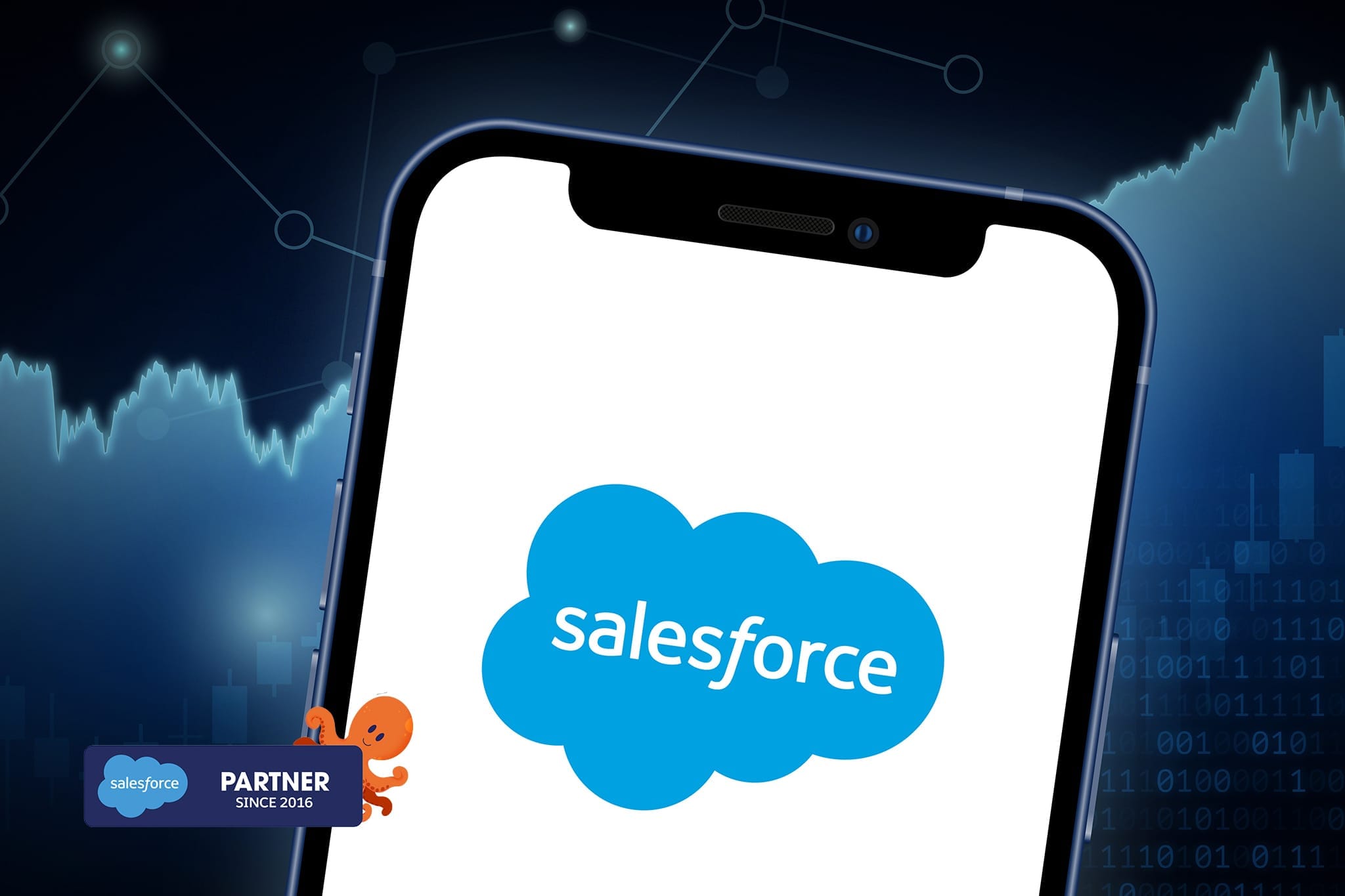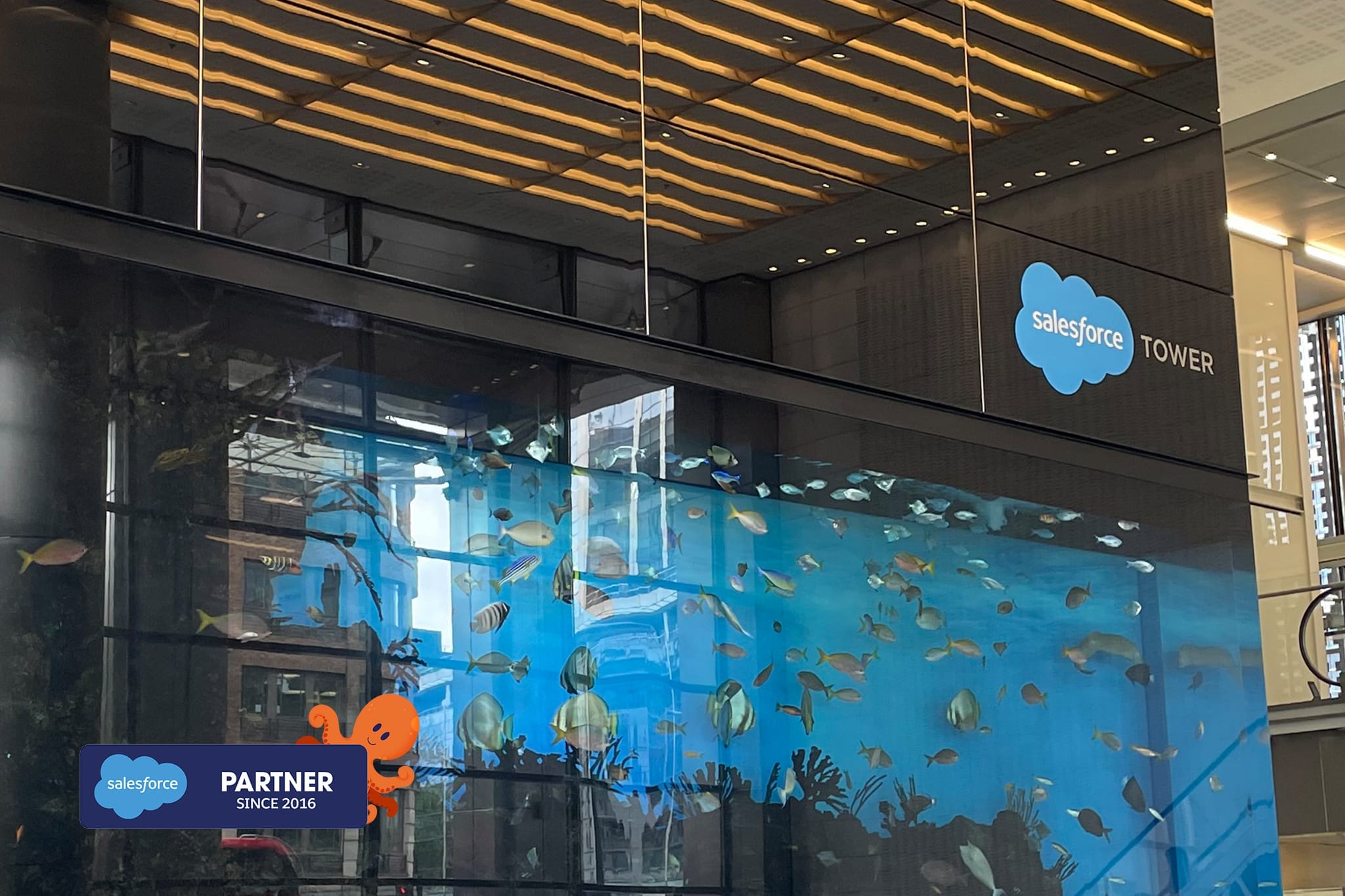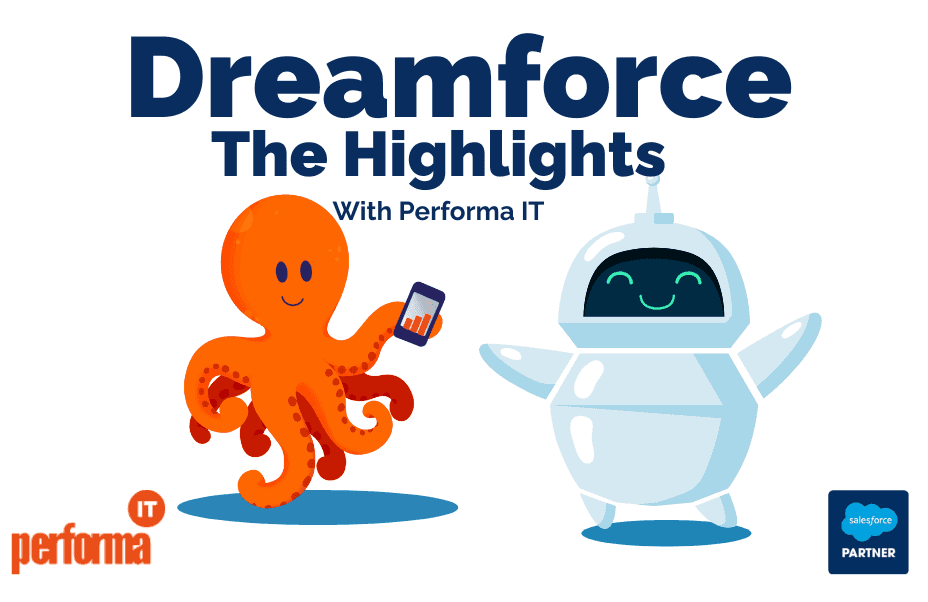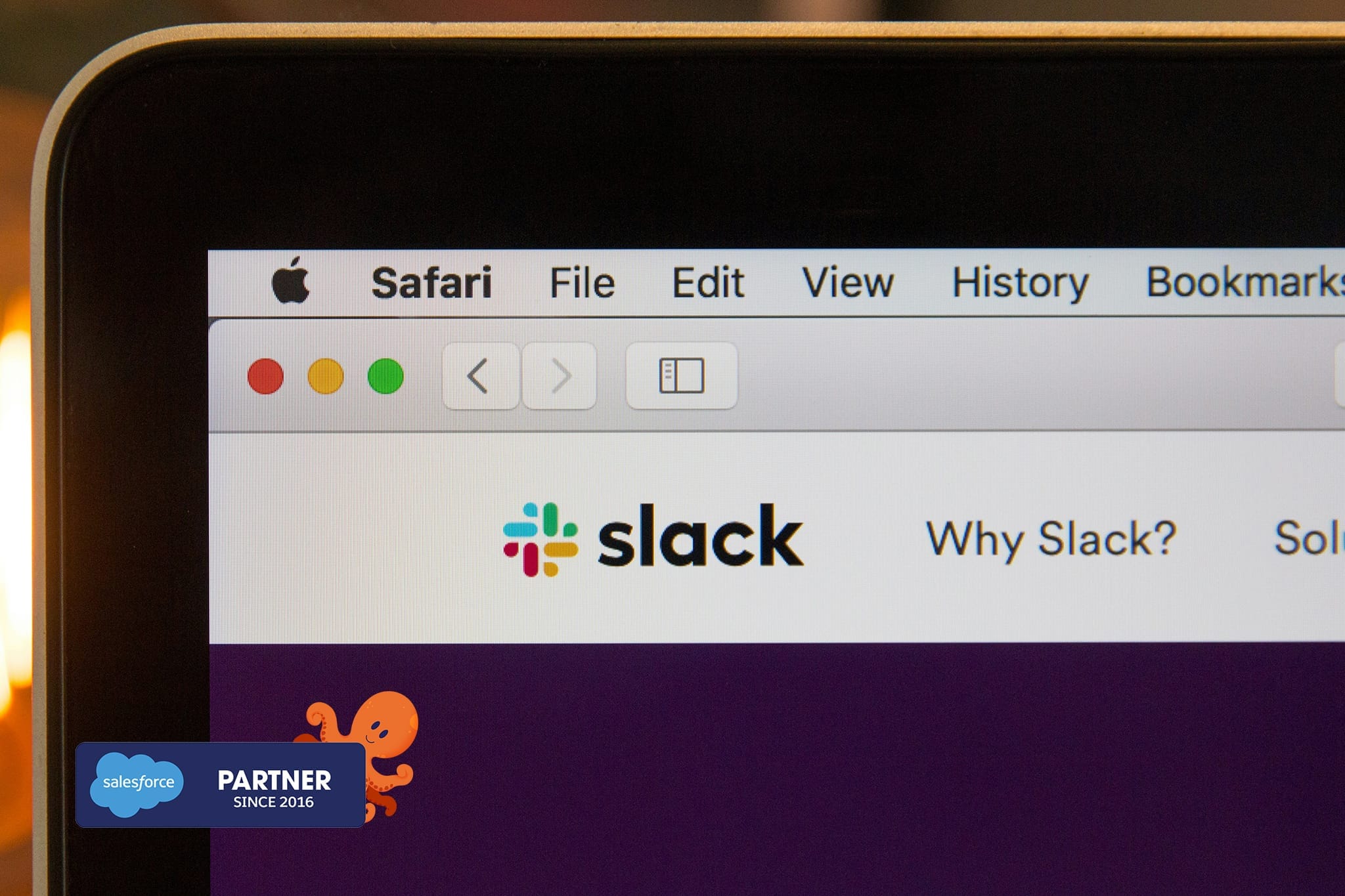It’s no surprise that this year’s Dreamforce will be focused on one key theme: AI. Specifically, Agentforce. Agentforce is Einstein Copilot reinvented, with the key addition of collaborative autonomy. But with 1,500 sessions to watch, Dreamforce can seem a bit daunting! So, what are the key takeaways? These can be gleaned from the Dreamforce keynote, and we have provided a summary of the 90-minute presentation to provide you with the Dreamforce highlights.
- Introduction
- A Vision for Agentforce: Mark Benioff, CEO
- Explaining Agentforce: Clara Shih, CEO of Salesforce AI
- Live Demo of an Agentforce User Story: Patrick Stokes, EVP of Product and Industries Marketing
- Where Data Cloud Comes In: Sanjna Parulekar, VP of Marketing
- Use Cases for Agents: Leah McGowen-Hare, SVP of the Trailblazer Community
- Key Announcements
1. Introduction
Whether Sales, Marketing, Service, or Commerce, Salesforce now boasts an ‘Agentforce layer’ to its 360 suite, meaning that you can deploy autonomous agents to complete actions by harnessing your business data. Salesforce’s aim for Dreamforce 2025 is to show its customers the power of leveraging every cloud and every agent, on one trusted platform.
The leading CRM giant emphasises that you shouldn’t have to ‘DIY your AI’, meaning that all the hidden costs, effort and resources associated with typical machine learning models (MLMs) are eliminated with this new innovation. All of the functionality is available in the Salesforce platform; no training, no disconnected data, no investment in new resources, no code.
That all sounds great, but where do you start? Well, Salesforce recommends working backwards from the value. Once you have identified the benefit, whether this is reducing toil, reducing cost, or enhancing experience, you can then roadmap how to extract that value from the system.
2. A Vision for Agentforce with Mark Benioff, CEO
In his opening speech, Marc Benioff welcomes an era of AI, envisioning “humans with agents driving customer success together with Salesforce.”
He acknowledges that their ‘second wave AI’ offering of copilots did not perform exactly as customers wanted them to, with no real augmentation or autonomy and no substantial indent in workload. Today, the team is pushing Salesforce to the next step – Agentforce. Marc urges that this is the most exciting and important aspect of Dreamforce ‘25, showcasing technology never seen before.
“Why are we struggling with chatbots, copilots and MLMs, when we can create technology to just take care of business? With all compliance and governance included across the industries so you can deploy the technology as you need it… A single, professionally managed, secure, reliable platform that nurtures all those stakeholders that are so important for your company.”
Following on from predictive functionality to the evolution of copilots, we are now in the third wave of AI. Marc emphasises that “innovation and AI is in the DNA of Salesforce” and that these brand new out-of-the-box and customisable agents are the “biggest breakthrough [Salesforce] has ever made.”
By introducing new, trusted, and secure functionality to the CRM that you know and use day to day, Salesforce has provided its customers with instant scalability with a very high level of accuracy and the lowest hallucinations (incorrect or misleading results) we have seen. This is because we can now harness the data, metadata, workflows, security, and sharing models that we have trusted for the past 25 years to create a more accurate AI.
This innovation, which will be generally available in October, is easy to build, requires no code, is instructed by natural language and is notably the most accurate AI in the world. Even better – it is built right into the Salesforce 360. The more customer touchpoints you have with Salesforce, the more AI can help you improve your business with the unified metadata platform.
3. Explaining Agentforce with Clara Shih, CEO of Salesforce AI
CEO of Salesforce AI, Clara Shih, begins her presentation with a striking statement; “the future is AI as commonplace as Apps and Webpages”.
She goes on to outline the five components of building a next gen Salesforce AI agent:
- A role: for example, a Sales Development Rep, Account Executive, or Service Agent.
- Data: which is already existing in Salesforce; custom objects, slack conversations, knowledge articles, metadata (structured or unstructured), and even external data can be activated by Agentforce.
- Actions: in essence; what are the workflows, the automations to get the job done? Prompts, flows, apex code and Mulesoft APIs can be ‘point-and-clicked’ and used to empower agentforce.
- Channels: where customers and employees are interacting with agents (for example, whatsapp, voice, email, messenger etc).
- Trust and security: this exists within the Einstein Trust Layer – every Agentforce implementation comes pre-built with prompt injection defence, data privacy and guardrails e.g. toxicity filters and monitoring.
“Everything you have ever done becomes the guide and the guardrails for your autonomous Agentforce.”
This statement means that, providing that your data is clean and harmonised, everything you need to leverage the power of Agentforce already exists, ready to go, in your Salesforce system.
Clara introduces the Atlas Reasoning Agent, which is the brain of Agentforce; continuously looping to be sure it can achieve your goal. It harnesses both structured data (such as databases, objects and tables) and unstructured data (such as email bodies, videos and images) to take action across the customer 360, which might manifest in activities such as engaging with a prospect, confirming a reservation, or serving a customer. Atlas knows when and how to seamlessly escalate to one of your service reps if it doesn’t yet have the capability to solve a request. The beauty is, the more you use it, the smarter it gets – and all outcome data is proprietary to your business, creating strategic advantage over time.
To conclude this deeper dive into how Agentforce was designed, we are left with some enticing statistics. Based on customer benchmark data, Agentforce boasts 33% greater accuracy and 2x more relevancy than the other leading models. This data can give users the confidence to delve into this new technology, and Salesforce has provided over 100 industry-specific use cases and out-of-the-box actions as a great place to start.
4. Live Demo of an Agentforce User Story with Patrick Stokes, EVP of Product and Industries Marketing
If the standard Agentforce actions don’t fit your use cases, it is also simple to customise and build your own with Agent Builder in Agentforce Studio. Patrick Stokes, EVP of Product and Industries Marketing joins the Dreamforce keynote team to provide a live demo of how a Salesforce customer is using Agentforce to revolutionise the way they do business.
Luxury fashion brand Saks Fifth Avenue debuted its Agentforce solution just prior to the Dreamforce kickoff. After initial conception, the pilot was up and running in only a week! To align with the shift in customer behaviour from in-store to online shopping, Saks pivoted to e-commerce and is now using Agentforce to provide a level of personalised service that would previously only have been attainable in person.
Agentforce makes customer recommendations based on preference, unlocking the ability to provide millions of customers with a personal stylist. Now, a luxury experience can be delivered at scale and amplified to online channels, delighting customers with service that is personal and authentic.
Patrick gives the Dreamforce audience a live demo of ‘Sophie’, Saks’ agentforce agent, by giving her the ability to amend, refund, advise on and exchange an order – all in one phone call. Using multimodal AI, ‘Sophie’ can recognise the customer, apologise for any inconveniences, recall the order and date, recommend based on purchase history and even answer detailed queries about the product.
5. Where Data Cloud Comes In with Sanjna Parulekar, VP of Marketing
We are all familiar with the notion that the quality of AI output can only be as good as the input. In this segment, Sanjna underlines the importance of data quality. Salesforce’s Data Harmonisation tool, Data Cloud, is a great option for those needing to collate their information. With no resulting costs for manipulating your data within Salesforce, this product allows you to visualise your information, build workflows and apps, and power your agents.
Sanja elaborates on the advantages of Data Cloud, explaining that every single system you have to describe a customer does so in a different way. The great thing about Data Cloud is that it ‘harmonises’ all of your tools and platforms, enabling them to speak the same language. This is essential as AI needs data to understand your business. Data Cloud’s Retrieval Augmented Generation (RAG) enables you to search through every single piece of data, allowing users to augment prompts effectively (and take action).
To illustrate the power of unified data, Sanjna takes the live Saks demo a step further. Sanjna prompts ‘Sophie’ to retrieve policy data and fix a customer query in the matter of seconds, providing the customer with a refund after a discount was added to a product after purchase. This demonstrates that, with a few clear instructions, agents can retrieve the right data, and ground it in your prompt, easily creating a resolution and a response. Sophie is now empowered with all the data necessary to resolve the issue within a matter of seconds, where it would take a service agent hours of admin to sift through the policies. The best part? This is all done without training a single model.
6. Use Cases for Agents: with Leah McGowen-Hare, SVP of the Trailblazer Community
Senior VP of the Trailblazer Community, Leah McGowen-Hare closes out the speakers with snappy examples of use cases for Agentforce:
- Slack: Humans and agents collaborating in a Slack channel to make swift, informed, data-driven decisions.
- Marketing Cloud: Summarise what customers are saying from unstructured data. From this, agents can suggest actions from analytics, creating a campaign based on customer sentiment.
- Service Cloud: All customer interactions and data can be summarised for the advisor in seconds, allowing agents and humans to work together to resolve cases.
- Retail Cloud: In-store interactions enhanced and guided by Agentforce, giving customers a seamless multi-channel experience.
These are just a number of the use cases that can be found in Salesforce’s new AI library, available to explore here!
7. Key Announcements
The Keynote concludes with two major announcements from Salesforce.
Firstly, Marc Benioff announces the launch of Salesforce foundations: available for enterprise and above. This offering grants users automatic access to the key Salesforce products such as Sales, Service and Marketing. With this, customers can build out their 360 even further, ready to unlock the power of Agentforce across their organisations.
The second key announcement is that an Agentforce World Tour is excitingly scheduled to take place this Autumn! Visit www.salesforce.com/agentforce/ for more information!
Summary
In summary Salesforce has declared a ‘hard pivot’ to autonomous AI. We are excited to see how these groundbreaking new technologies shape the future of work!
As Patrick Stokes enthused, “if you can describe it, you can get Agentforce to do it”. It’s apparent that we haven’t even begun to scratch the surface of what Salesforce AI can do for our businesses.
For a more in depth overview of Salesforce’s Agentforce offering, take a look at our article ‘The Dawn of Agentforce’. If you’re interested in learning how we can leverage Salesforce AI to save time and resources, give us a call on 0117 230 2390 or claim your free AI workshop below!










